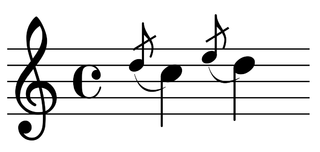If your playing seems a bit uninspired as of late, try
sprinkling some grace notes into the mix. Grace
notes are sonic embellishments that add a bit of sparkle to a melody. A few
well-placed grace notes can be the difference between a humdrum tune and one
that’s truly remarkable. They’re pretty easy to play too. Grace notes are
written as a smaller, passing notes played just before the main note. They are
often combined with legato techniques such as hammer-ons,
pull-offs and slides to make the change from grace to main note quicker. A
grace note increases the emotional impact of the main note without detracting
from its dominance in the melody.
The following 12 tips will teach you a little something about grace notes so
that you can start incorporating them into your playing today:
1. Principal and auxiliary notes. In the context of grace notes, a principal (main or regular) note is your melody note. An auxiliary note, like a grace note, is a note that supports or enhances another note when added to it. Grace notes are ornaments that decorate or adorn principal notes.
2. Musical notation. Grace notes are written as small notes with a dash through the stem in standard notation and with small numbers in tab. They are placed before a principal note and are often tied to them with a small slur, which suggests a smooth, fluid transition between the auxiliary and the principal note. A grace note is printed smaller to indicate that it is melodically and harmonically nonessential. It also makes it easier to notice the ornament as it clearly stands out as different than the normal-sized note and should therefore be played differently.
3. Rhythmic value. Grace notes don’t have a rhythmic value. It’s the following note, the principal, that has the full rhythmic count of whatever note it happens to be. For example, if the grace note is the open fifth string A and the principal note is the fifth string, second fret B, you’d hit the open A string as you begin to count “one,” but before you finish saying “one,” you would want to be on that B note. Grace notes should be played light and fast. They don’t have a beat of their own but are part of a beat.
4. How to play grace notes. The word “grace” suggests that notes should be performed in an elegant and fluid fashion. They are also played fast, like in-the-space-of-a-gnat’s-eyelash fast. Grace notes come in two varieties—ascending and descending—and can be played in three different ways: As a quick hammer-on in an ascending movement with the grace note written from below the principal; as a quick pull-off in a descending movement with the grace note written from above the principal; or as a quick slide from grace to principal note with the grace note written from either above or below.
5. Execute an ascending grace note. Beginning with a fifth string, second fret B grace note fretted with the middle (second) finger, and using a fifth string, third fret C fretted with the ring (third) finger as your principal note, play the B note and very quickly hammer on the C note. The notes are played smoothly, one followed immediately by the other within the applicable beat.
6. Execute a descending grace note. Beginning with a fifth string, third fret C grace note fretted with the ring finger and using a fifth string, second fret B fretted with the middle finger as your principal note, play the C note and very quickly pull-off to the B note. Again, this transition should be fluid with one note followed immediately by the other within the applicable beat.
7. Now hear this! The grace note does not have to ring as a clear note. Its job is to imply ascending or descending motion and set up the following note that does ring clearly.
8. Goof note. It might help to think of grace notes as goofed-up notes—a note that you hit by mistake and then immediately replace with a second, correct note almost instantaneously. You know, before anyone notices.
9. Don’t fear the grace note. Fear is the one thing you want to avoid when playing grace notes. Fear causes tension, and tension causes lunging, and lunging will serve only to make the ornament clunky. Tension will also tire you out. Instead, plan ahead and know the grace note is coming in time to land it.
10. Jumpers. Grace notes can jump one, two, even three frets, depending on what direction the tune is coming from and where it’s going.
11. Troubleshooting grace notes. If you have trouble playing a particular grace note, simply leave it off. Grace notes don’t affect the melody.
12. Everything in moderation. Although it is certainly possible to play grace notes before every note in a melody, don’t. It would soon become irritating and the grace notes would lose their charm. Limit the use of grace notes to a few effective places.
About the Author
Kathy Dickson writes for the online guitar lesson website GuitarTricks.com.



